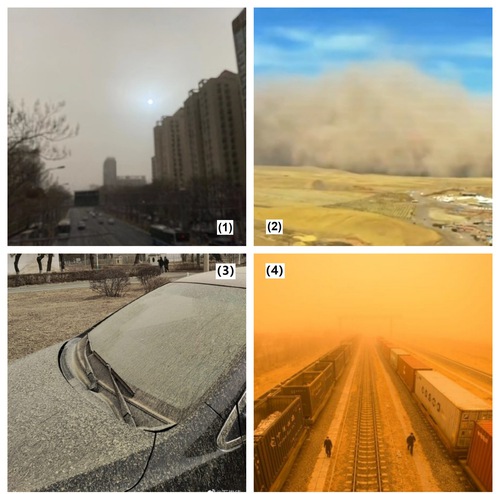(Minghui.org) Many areas in northern China have recently experienced sandstorms. During such an attack in Beijing on March 22, 2023, the sky went dark and the sun appeared blue. On the same day, raining mud was seen in Jilin and Liaoning Provinces of northeast China. Lots of vehicles as well as pedestrians were covered by mud with no exceptions.
 Recent sandstorm in northern China: 1) Upper left, blue sun in Beijing on March 22. 2) Upper right, 100-meter “sand wall” in Gansu Province. 3) Lower left, raining mud in Jilin and Liaoning Province. 4) Lower right, cargo trains at a train station in Erenhot of Inner Mongolia.
Recent sandstorm in northern China: 1) Upper left, blue sun in Beijing on March 22. 2) Upper right, 100-meter “sand wall” in Gansu Province. 3) Lower left, raining mud in Jilin and Liaoning Province. 4) Lower right, cargo trains at a train station in Erenhot of Inner Mongolia.
Beijing
During the recent annual National People’s Congress and the Chinese People’s Political Consultative Conference in Beijing earlier this month, a sandstorm struck the city and the sun appeared blue. Such weather appeared again on March 22. The high-altitude sand and dust engulfed Beijing in the morning. The yellow sand was everywhere, from the sky to the ground with an earthy smell in the air. The air quality was at a severely polluted level.
Citing information from the China Meteorological Administration, the Central News Agency reported many places in China had blowing sand or floating sand dust weather between 8 a.m. March 22 and 8 a.m. March 23. They included south Xinjiang, north Qinghai, Ningxia, Inner Mongolia, Shaanxi, Shanxi, Hebei, Beijing, Tianjin, and central Heilongjiang. Among them, southeast Inner Mongolia, Beijing, and north Tianjin had sandstorms (visibility of less than 1 kilometer), while some areas experienced strong sandstorms (visibility of less than 500 meters).
According to information from the Beijing Ecological Environment Monitoring Center, the concentration of suspended particulates went off the chart on March 22. The level of PM10 (inhalable particulate matter of 10 micrometers or smaller) increased sharply at a rate of 500 μg/m3 per hour to 1490 μg/m3. The peak concentration reached 1,667 micrograms per cubic meter. Experts said the severe sand and dust weather was the worst this year.
The Beijing Meteorological Service issued a yellow dust warning in the early morning of March 22 since visibility was less than 1,000 meters. Beijing City Park Management Center also announced the closure of park boating and cable car service at Xiangshan Park touring site.
With a gray sky, blue sun, sandstorms, and polluted air, some netizens described it like end of the world.
Raining Mud in Northeast China
As strong winds and sandstorms ravaged northern China, raining mud appeared in Northeast China such as Changchun (Jilin Province) and Shenyang (Liaoning Province). Many pedestrians on the road, as well as vehicles, were covered by mud.
According to the National Meteorological Center, strong winds and dusty weather were predicted in Northwest China, northern China, Northeast China, and some other areas.
Another report showed that Northwest China and northern China had dusty weather on March 21. On the morning of March 22, National Meteorological Center continued to issue yellow sandstorm warnings.
Sand Wall in Gansu Province
On March 20, netizens in Gansu Province took some photos of the sandstorms at Shandan Racecourse in Zhangye City. The sand was high and formed a 100-meter sand wall, as if it would crush buildings on its path.
China Weather Network reported a new wave of cold air could affect the majority of places in China between March 20 and 23. People would experience cooling, dust, rain and snow, and stormy weather. Between March 22 and 23, it would sweep through northern China and Northeast China, forming probably the largest dust weather in northern China this year.
Beijing News reported some areas in Gansu Province had experienced the worst dust weather this year, including Zhangye, Dunhuang, and others. Some areas have level-9 strong gale (47 – 54 mph). The visibility would be less than 200 meters.
The strong wind moved forward slowly with fine sand and visibility was low. Ganzhou Airport in Zhangye started emergency measures to protect aircraft from the sandstorm. Jinchang, Jiuquan, and other areas also issued yellow-level sandstorm warnings. People were urged to reduce outdoor activities and motor vehicles were recommended to reduce speed.
Orange Sky in Inner Mongolia
News media in China said numerous cities in Inner Mongolia had dusty weather, including near the border in Alax Left Banner. The dust and sand formed a sand wall dozens of miles long. The sky went dark.
Another report predicted sandstorms in Erenhot on March 21. The sky also went orange at 5 p.m.
At 6 p.m. on March 21, the Inner Mongolia Meteorological Observatory issued an escalated orange warning signal: within six hours, there may be strong sandstorms in the north of Baotou City, the north of Ulanqab City, and the northwest of Xilingol League, with visibility less than 500 meters.
Zhang, who lives in Erenhot, Inner Mongolia, told the media that he has lived there for 17 or 18 years and feels that this is the biggest sandstorm yet. He said that at around 5 p.m. on March 21, he and his colleagues were still printing documents in the office, when they suddenly looked up and found that it was dark and the sun could not be seen.
Mr. Zhang also said that shortly after the sandstorm started, the temperature also dropped sharply. The highest daytime temperature in Erenhot during the day was 14°C, but the lowest temperature at night dropped to -13°C, and the highest temperature the next day would only be -1°C.
All content published on this website is copyrighted by Minghui.org. Minghui will produce compilations of its online content regularly and on special occasions.
Category: News & Events










